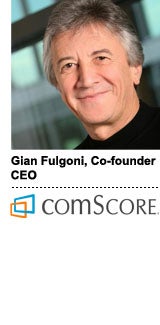ComScore will offer viewability and nonhuman traffic detection for free on desktop and mobile, the company said Wednesday.
ComScore’s move to eliminate fees on what it terms “baseline” metrics coincides with its launch of a self-serve interface that integrates both its fraud detection and viewability reporting.
The product, which was partly built on comScore’s acquisition of MdotLabs, will be generally available by June, said comScore CEO Gian Fulgoni.
The company claims a self-service model enables it to roll out no-fee reporting for viewability and fraud detection on a wider scale.
However, comScore anticipates many clients will still want full-service support for services such as tag implementation and web analytics. So, in some respects, the free viewability reporting can serve as an upsell into comScore’s larger analytics suite.
ComScore’s self-serve viewability and fraud detection tool uses baseline Media Rating Council definitions for viewability, so display ads, for example, will be considered viewable if at least half of the pixels are in view for one second.
If clients wish to create customized viewability definitions beyond the standardized free metric, they can add audience-, reach- and lift-based measurement as additional services (at varied costs).
“There is this growing recognition on our part that the industry has become somewhat obsessed with viewability and, to some degree, viewability is being erroneously thought of as an effectiveness metric when it isn’t,” Fulgoni told AdExchanger. “Viewability is also something we’ve seen advertisers struggle with. These metrics seem to be all over the place.”
Although comScore considers viewability reporting table stakes, it claims other metrics factoring in the creative, audience demographic, reach, frequency and attitudinal and sales lift aren’t getting the necessary degree of attention.
“Ultimately we think it will help the industry reduce friction in campaign measurement and get the industry focused on other metrics which have been ignored,” Fulgoni said.
“Of course, we’re not so altruistic that we’re doing this without anticipating some benefit to us since we provide all these other metrics and services in addition to viewability,” he added.
Offering free viewability reporting is not the first time comScore stirred things up in the third-party measurement space.
The company went through well-publicized litigation five years ago when it sued analytics competitors Moat, DoubleVerify and AdSafe (now Integral Ad Science) for alleged patent infringement around its ad effectiveness solutions. Nielsen sued (and settled) with comScore over similar allegations one year prior.
But the third-party measurement space has become increasingly competitive since comScore’s early legal rumbles.
Oracle revealed its intent to acquire Moat last week and some industry observers speculate Nielsen may put the moves on competitor Integral Ad Science to remain competitive.
So where does that leave comScore, faced with its own challenges stemming from an accounting mishap and subsequent stock delisting?
Fulgoni says he feels confident about comScore’s position, despite recent changes in the competitive landscape.
“Our decision to [offer free viewability reporting] has been months in the making since we needed to build the technology to do a self-serve product,” he said.
Fulgoni emphasized that the Moat and Oracle announcement had nothing to do with this product’s launch.
“If you look at campaign measurement, there really are only two players that measure the demographics of an audience, as well as the reach and the frequency,” Fulgoni said. “That’s us and Nielsen.”















